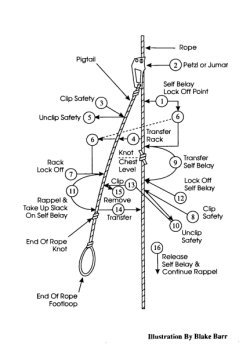THE PIGTAIL KNOT SHUNT
By Oren Tranbarger
Introduction
One of the skills required for vertical competency is rappelling over a knot. Changeover modes and climbing up over a knot are easy compared with rappelling down over a knot. A Mitchell system is perhaps the best conventional system to use for downclimbing over a knot, but some cavers do not use a Mitchell system or might not have the necessary gear (double-roller chest box) to implement such a system. After practicing various techniques in rappelling over a knot and contemplating the problems encountered, a new technique was developed for the required maneuver. This technique allows the caver to remain seated in the seat harness and requires no upper body strength or special equipment. The pigtail knot shunt can be safer since three points of contact are usually maintained while hanging on the rope. The following technique is especially easy to use if a self-belay device is used.
Self-Belay Devices
The merits of self-belay devices are undisputed unless such a device is poorly designed and interferes with rappelling. Recent incidents have occurred where a life might have been saved had the unfortunate victims been using a self-belay device and always maintained a second point of contact on the rope. Conventional self-belay devices are described in On Rope. Also, a bar-release design for a Gibbs that I have found useful is described in The Texas Caver, June 1991, pp. 63-64.
Pigtail Knot Shunt Design
The pigtail knot shunt consists of a Jumar ascender tied to a 7/16-inch rope about 15-20 feet long. The end of the rope should have a loop big enough for standing (if that should be necessary) and a knot about 3 feet above the loop for safety. In application, the Jumar is attached to the rope about 7-10 feet above the knot on the standing rope. The caver simply transfers over to the pigtail, rappels past the knot, and then transfers back to the standing rope below the knot. Once on the standing rope below the knot, normal rappelling is resumed.
Rappelling Equipment And Procedures
In rappelling over a knot, the accessory equipment required is: (1) the pigtail knot shunt (carried on the seat harness); (2) a self-belay device; and (3) a safety. If a self-belay device were used that cannot be released under load, then an ascender would be used on one foot to rise up on the rope for releasing the self-belay device. The following steps describe the procedure:

- Rappel down above the knot and lock off using the self-belay device about 5 feet above the knot.
- Attach the Jumar and the pigtail above the self-belay device as shown in the figure.
- Attach the safety on the pigtail as shown in the figure at chest level with slack in the tether.
- Transfer the rack from the standing rope to the pigtail.
- Unclip the safety from the pigtail.
- Continue rappelling on the pigtail by releasing the self-belay device.
- Stop the rappel at neck level with the knot and tie off the rack.
- Attach the safety about 1-foot below the knot on the standing rope as shown in the figure.
- Remove the self-belay device above the knot and reposition it below the knot.
- Remove the safety in Step 8.
- Untie the rack in Step 7 and continue rappelling on the pigtail.
- As rappelling continues, lock off the self-belay device.
- Reattach the safety on the pigtail above the rack as shown in the figure.
- Transfer the rack from the pigtail to the standing rope.
- Remove the safety in Step 13.
- Continue rappelling on the standing rope by releasing the self-be-lay device.
- After completing the rappel, one of two things will happen:
(1) another caver will follow; or (2) the first one to rappel will ascend. In the first case, the following caver would rappel down slightly above the Jumar. At this point, simply reach below, detach the Jumar, rappel farther down the rope, and reattach the Jumar overhead. After reattaching the Jumar, the above procedures would be repeated. If following carets did not wish to use the pigtail, any standard technique for downclimbing over the knot could be used.On ascending, the first one up the rope would climb over the knot using any conventional technique. On the way up, the Jumar and pigtail would be detached and carried to the surface.
Summary
The above technique for rappelling over a knot always maintains two points of contact, minimum, on the rope. With the exception of brief transfer and rappelling periods, three points of contact are maintained. Although more steps are involved than conventional techniques, the advantages are that: (1) a sitting position can be maintained throughout the procedure; (2) no super upper body strength is needed; (3) no special climbing gear is required; and (4) the pigtail does not hamper other techniques that might be used for downclimbing. A self-belay device should be used in performing the above procedures. With practice, the pigtail technique can be accomplished quickly without much thought.
Return to the Top of the Page
Return to the NH #45 Contents Page
Copyright © 2000 Vertical Section of the NSS, Inc. - All Rights Reserved.